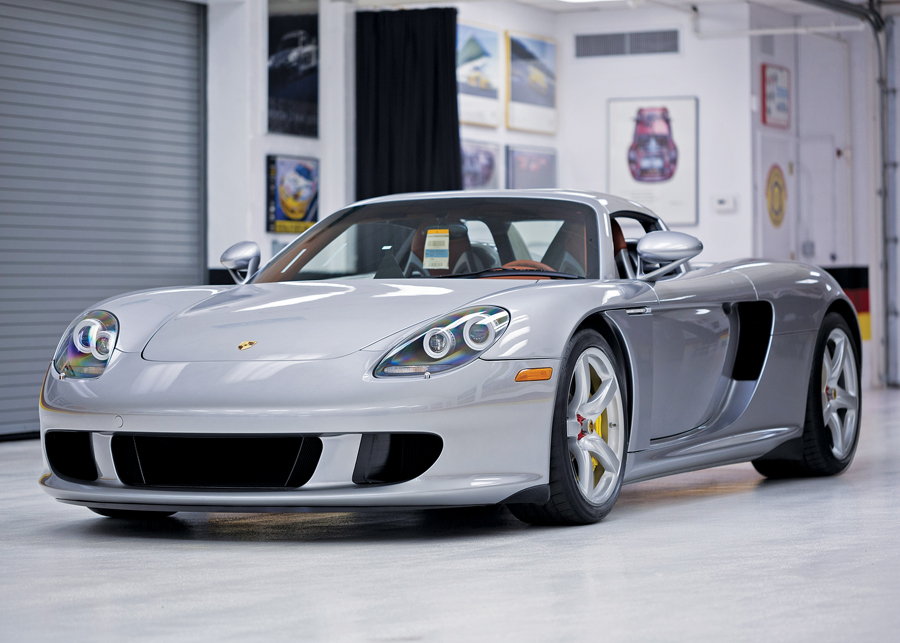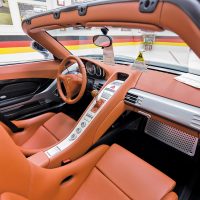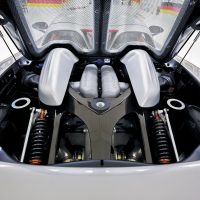- 5.7-liter, 605 horsepower 10-cylinder engine
- 6-speed manual transmission
- Only 24 miles on the odometer
- Freshly serviced, factory-fresh, turn-key ready
- Believed to be the lowest-mileage privately owned Carrera GT on the planet
- One owner, delivered new to Ohio
- GT Silver Metallic paint over Terracotta leather
- Porsche Certificate of Authenticity
- Factory Terracotta luggage
- Factory car cover still sealed in plastic delivery bag
SCM Analysis
Detailing
| Vehicle: | 2004 Porsche Carrera GT |
| Years Produced: | 2004–06 |
| Number Produced: | 1,270 |
| Original List Price: | $448,400 (base) |
| SCM Valuation: | Median to date, $781,000; high sale, $1,100,000 |
| Tune Up Cost: | $2,250 for tune-up; $7,275 for major service |
| Chassis Number Location: | Base of windshield, driver’s side door jamb, tag in truck under covering |
| Engine Number Location: | On timing cover at center-rear of engine bay |
| Club Info: | Porsche Club of America |
| Website: | http://www.pca.org |
| Alternatives: | 1994–98 McLaren F1, 1995–97 Ferrari F50, 2004–05 Maserati MC12, 2005–06 Ford GT |
| Investment Grade: | B |
This car, Lot 168, sold for $800,000, including buyer’s premium, at Auctions America’s sale held in conjunction with the Hilton Head Concours d’Elegance on November 5, 2016.
First, a concept car
Porsche introduced the Carrera GT concept car at a special event held at the Louvre Museum in Paris in late September 2000.
Factory personnel, race car drivers, including Walter Röhrl, the press, and invited dignitaries were treated to Porsche’s vision of a supercar.
The engine was derived from the V10 for the Footwork Formula One car from the early 1990s. The V10 was used again circa 1999–2000 in a prototype endurance race car dubbed the LMP 2000, which was intended to run Le Mans and other FIA races, but that project was shelved. The Carrera GT’s body design was reminiscent of the GT1 homologation cars of 1996–98, which were built in just 22 examples.
The Carrera GT was the third iteration of a Porsche supercar.
The 959 was first, from the mid-1980s. It featured advanced engineering for the era, including computer-controlled four-wheel drive, aluminum and carbon-fiber panels, and 444 horsepower. Porsche built 337 of them.
The 1996–98 911 GT1 was a mid-engine two-seater with an engine derived from the racing 962 with 544 horsepower. It was a homologation special for its eponymous racing brother, with just 22 road-going examples.
Just six years later came the Carrera GT. Historically, these Porsche supercars sold over MSRP during the delivery months and then declined in value. Down the road 10-plus years, those tables turned, and all three cars are highly prized today.
Dropping racing for an SUV and supercar
After 1998, Porsche dropped top-tier racing, much to the dismay of their engineers and fans.
The upcoming Cayenne SUV stretched Porsche’s engineering resources. They nonetheless developed the Carrera GT partly under competitive pressure from Ferrari, Mercedes, Aston-Martin and their sister company Volkswagen — and partly to keep their race engineers busy and happy.
The motoring press and the public were enthusiastic about the concept unveiled at the Louvre. That interest — plus favorable financial forecasts for the Cayenne — ultimately gave Porsche the courage to produce the Carrera GT.
The production car was introduced at the Geneva International Motor Show in the spring of 2003. Deliveries started in early 2004 and ended in mid-2006.
The car’s V10 engine was an all-aluminum, unusual 68-degree V, with 5,733-cc displacement, DOHC, four valves per cylinder, and 8,400-rpm redline developing 605 horsepower with 435 foot-pounds of torque.
The gearbox was a 6-speed manual mated to Porsche’s racing clutch. Suspension was inboard, coil-over shocks, lying hortizontally and activated through pushrods and rocker arms. Porsche ceramic brakes — 15 inches in diameter — provided the stopping power. The chassis/body monocoque was built in carbon fiber at the Italian firm ATR Group, which also built them for other exotic automobiles. The Carrera GT body reportedly used over a thousand pieces of resin cloth, which was autoclave-bonded with heat and pressure to form the structure.
A departure for Porsche — it was not a lightweight
The GT weighed in at 3,148 pounds, heavy by Porsche performance-car standards but nonetheless delivering 5.2 pounds per horsepower. The car was actually luxurious, with a removable top, full leather, a luggage set, radio, navigation and air conditioning all standard equipment.
Porsche assembled the GT at the Cayenne plant in Leipzig, with engines and gearboxes coming from Stuttgart. Originally, only five exterior paint colors were available: GT Silver, Seal Gray, Guards Red, Fayence Yellow, and Basalt Black. For 2005–06 deliveries, Porsche accepted orders for other factory and paint-to-sample colors. Today, unless you chose Sepia Brown, those colors carry premium prices.
Supercar performance — but it did not sell out
Car and Driver reported the Carrera GT to be good for 0–60 mph in 3.5 seconds, 0–100 mph in 6.8 seconds, with a top speed of 205 mph. Their quarter-mile test recorded 11.2 seconds and 132 mph. All those numbers were a couple of tenths plus or minus vs. Ferrari’s Enzo, although Porsche’s brakes were superior, as were its slalom and skid-pad results. Also, the Enzo was over $200,000 more expensive — and nowhere near as much fun to drive.
Even so, the Carrera GT carried an MSRP of $448,400. Porsche originally planned to produce 1,500 of them. Sales were slower than anticipated, however, and the curtain came down in 2006 after 1,270 examples had been made. Reportedly, 675 Carrera GTs came to North America, 644 for the U.S. and 31 for Canada.
Whee! A day driving a CGT and a 993 GT2
I spent a day in the hills outside San Diego driving a Carrera GT and a 993 GT2, thanks to good buddy Joerg Ineichen. The Carrera GT was eye-opening. On the not-winning-us-over side was the racing clutch, two small-diameter discs that require engaging without touching the gas; once engaged you need to instantly and calmly execute normally. It’s tricky. You kill the engine or smoke the tires until it all comes into focus. Once you get accustomed to it, it’s still slower than dumping the clutch on a 911.
The gearbox is typical Porsche terrific. The linkage is all rods, so it goes snick, snick, snick in a nicely mechanical way. No fly-by-wire here. No Enzo automatic box. You’re involved when you drive a Carrera GT. It handles predictably and goes exactly where you point it, with excellent steering feel and inputs. As for power, the car is a roller skate with JATO bottles, and, of course, no turbo lag.
Best of all were the glorious mechanical noises taking place immediately behind your head thanks to the solid valve train, mid-engine placement and reduced sound deadening. Porsche engineers are drivers too.
The price roller coaster
Porsche fulfilled all possible demand for the Carrera GT to get 1,270 cars sold over two-plus years. Predictably, prices declined after deliveries were completed.
In the fall of 2010, a friend bought a 4,000-mile example for $300,000 after all service was brought up to date. That was likely the low ebb for Carrera GT prices. After that, cars appreciated and sold for $450,000–$550,000 just a few years ago. When the 918 Spyder deliveries started in 2015, Carrera GTs appreciated anew. Why?
First, 918 Spyder buyers loved their cars, and some then wanted a Carrera GT, sometimes also a 959 and maybe even a GT1 — just to have the full run of Porsche’s supercars.
Second, people looked at the hybrid 918, and said, “Oh my. The Carrera GT is the last analog super Porsche, rip-snorting V10, 6-speed stick shift, pure driver’s car.” Prices of Carrera GTs boomed. Very low-mileage or special-color examples went well over $1,000,000. That boom has ended now. Prices are returning to earth.
Our subject car
Our 24-mile example at the Hilton Head auction had the big plus of very low mileage with a full servicing, but it also had the common paint/interior combination of GT Silver Metallic over Terracotta. These are the archetypal colors for a GT. It did not sell on the block, but Auctions America later negotiated a sale at $800,000, all in.
I believe that the car would have brought over $1,000,000 in 2015, so the market has moved. We’ll watch Scottsdale and Amelia Island to see if the decline is confirmed. ♦
(Introductory description courtesy of Auctions America.)



